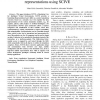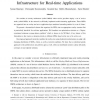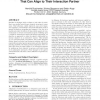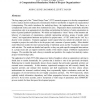162 search results - page 21 / 33 » Simulating Structural Change in Adaptive Organizations |
IJVR
2006
13 years 8 months ago
2006
This paper introduces SCIVE, a Simulation Core for Intelligent Virtual Environments. SCIVE provides a Knowledge Representation Layer (KRL) as a central organizing struc...
CN
2006
13 years 8 months ago
2006
We consider an overlay architecture (called OMNI) where service providers deploy a set of service nodes (called MSNs) in the network to efficiently implement media-streaming appli...
ATAL
2010
Springer
13 years 9 months ago
2010
Springer
Speakers in dialogue tend to adapt to each other by starting to use similar lexical items, syntactic structures, or gestures. This behaviour, called alignment, may serve important...
CACM
1998
13 years 8 months ago
1998
The long range goal of the “Virtual Design Team” (VDT) research program is to develop computational tools to analyze decision making and communication behavior and thereby to ...
JMLR
2010
13 years 3 months ago
2010
Learning dynamic Bayesian network structures provides a principled mechanism for identifying conditional dependencies in time-series data. An important assumption of traditional D...




